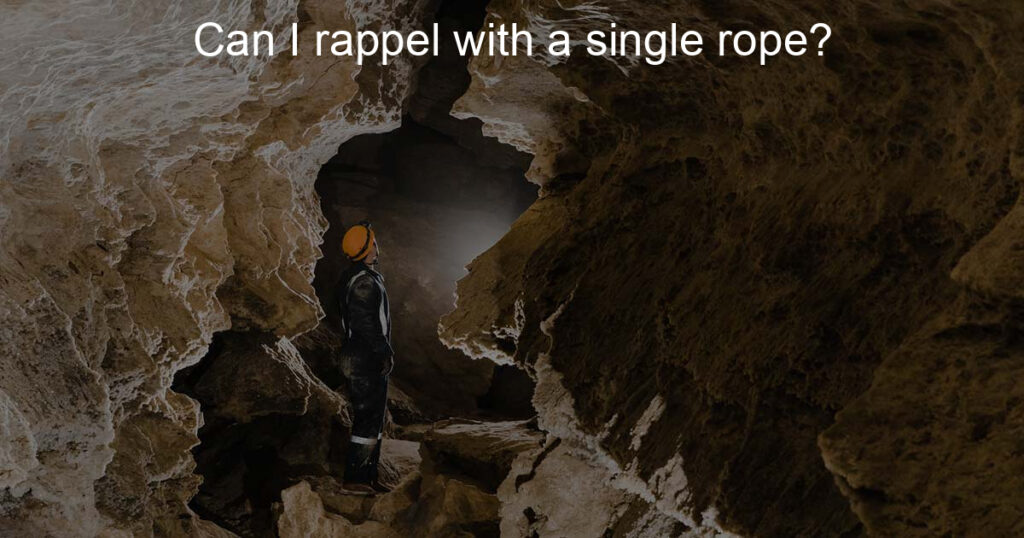Are you considering doing some challenging rappelling in your next caving expedition? If so, you’ll want to make sure you have the right equipment and safety measures in place.
Can I rappel with a single rope? But what if you only had a single rope? Is it possible to rappel with a single rope or is it potentially dangerous? It’s important that spelunkers, cavers, and cave explorers understand the capabilities of a single rope before they attempt any kind of advanced rappelling maneuvers while on their adventures.
Keep reading this blog post to learn more about how to safely use ropes when exploring caves and other underground spaces.
What type of Rope is Needed for Rappelling?
When it comes to rappelling, using the right kind of rope is essential for ensuring your safety. While it is possible to rappel with a single rope, it’s not recommended as it can put undue stress on the rope, and you run the risk of it breaking. Instead, it’s best to use a specific type of rope known as a “dynamic rope.”
This type of rope is designed to stretch, which helps absorb the impact of a fall. Additionally, dynamic ropes are thicker than regular climbing ropes, which adds an extra layer of protection. So if you’re planning on rappelling, make sure to invest in a good quality dynamic rope to ensure a safe and thrilling experience.
How to Rig Your Single Rope for Rappelling?

Rappelling is an essential skill for any rock climber or mountaineer. But what do you do if you only have one rope? Contrary to popular belief, you can absolutely rappel with a single rope.
The key is to rig your rope properly. One of the most common methods is to use a double rope technique. This involves folding your rope in half and attaching it to your rappel device with two separate knots. Another option is to use a backup knot, such as a prusik knot, for added safety.
Whatever method you choose, make sure to do a test run before committing to a full rappel. With the proper technique and precautions, you can successfully rappel with a single rope.
What are the Safety Tips for Rappelling with a Single Rope?
When it comes to rappelling with a single rope, safety is paramount. The answer to the question “Can I rappel with a single rope?” is yes, but there are certain precautions you need to take to ensure a successful descent.
It’s important to first choose the right rope and make sure it’s rated for rappelling. Additionally, always check the anchoring system before descending, as this could be a crucial factor in your safety. Moreover, you need to wear proper gear, including a helmet and gloves.
Finally, while descending, maintain a slow and controlled pace and listen for any unusual sounds that could indicate a problem with the rope. Remember, ensuring your safety during a rappelling adventure is of utmost importance.
What are the Different Types of Rappel Devices and How They Work?

Rappelling is an essential skill for climbers and adventurers. With multiple types of rappel devices available, it can be challenging to choose the perfect device to fit your needs.
However, the right rappel device can make all the difference in safety and ease of use. Whether you prefer a figure-8, ATC, or a Grigri, each device has unique features that set them apart. Figuring out which type of device to use can be a challenge, especially if you’re working with a single rope.
While it’s possible to rappel with a single rope, it’s crucial to ensure you have the right device for the job. In this article, we’ll provide insights on the various types of rappel devices available and how they work, helping you decide which one is best suited for your needs.
| Pros | Cons |
|---|---|
| Simpler Setup | Increased Rope Wear |
| Lighter Weight | Limited Length |
| Easier to Manage | Risk of Getting Stuck |
| Fewer Tangles | Increased Risk of Rope Damage |
| Faster Setup | Higher Risk of Rope Failure |
Remember, it’s important to carefully consider all factors when deciding whether to rappel with a single rope and to always follow safety guidelines and manufacturer instructions for any rappelling equipment. If in doubt, seek professional instruction or guidance.
Common Mistakes When Using a Single Rope for Rappelling and How to Avoid Them?

Rappelling with a single rope is a technique that requires a certain level of expertise, and one wrong step can lead to disastrous consequences. There are several common mistakes that people often make when using a single rope for rappelling, such as not tying a backup knot, using an old or damaged rope, and not ensuring the rope is long enough for the rappel.
To avoid these mistakes, it is essential to equip yourself with a checklist before every rappel and double-check your gear. Always inspect your rope for any signs of wear and tear, and ensure you have enough length to safely complete the rappel. By taking the necessary precautions, you can enjoy a fun and safe rappelling experience with a single rope.
What is the smallest rope you can rappel on?
Rappelling is an adventurous outdoor activity that requires proper knowledge and equipment. When it comes to choosing a rope for rappelling, it is important to consider its strength and diameter. While it is possible to rappel on a single rope, the smallest diameter recommended by experts is 8.5mm.
This diameter provides enough strength and control to safely lower a person down a cliff or rock face. However, it is important to always check the rope’s condition, weight limit, and compatibility with your rappelling device before using it for the descent. Always prioritize safety over convenience when selecting your rappelling gear.
Can you rappel a single strand on ATC?
When it comes to rappelling with an ATC, many climbers wonder if it’s possible to rappel with a single rope. The short answer is yes, but it’s important to take some precautions.
First and foremost, make sure you use a rope that is rated for single-strand rappelling. Secondly, test the rope beforehand to ensure that it’s long enough for your intended descent.
Finally, always keep your brake hand on the rope while rappelling to ensure a controlled descent. By taking these precautions, you can safely and confidently rappel on a single rope with an ATC.
Conclusion
All in all, rappelling with a single rope should be approached with both caution and experience. Because of the additional weight of the rope, descent speed increases and so do error margins.
While it is possible, it is not encouraged to beginners. Single-rope rappelling should be done only by those who have mastered the basics and have had experience with multi-rope rappelling. But once you have the right skills and knowledge, even this more unstable form of rappelling can be exciting and rewarding!
The only way to gain confidence in single rope rappelling is regular practice, so get out there into the great outdoors and enjoy!














